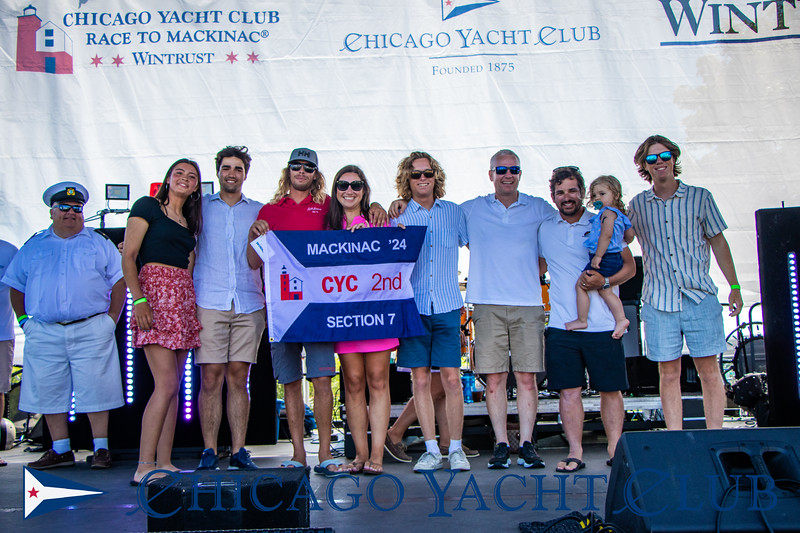By Andy Camarda
Edited by Carl Eaton
Each year, the Chicago and Bayview Mackinac Races are the most well-attended races on the Great Lakes. With the races starting on back-to-back weekends in July, nearly 300 boats pull out all the stops to try and collect these two prestigious trophies. The longer, 290 nautical-mile Chicago to Mackinac race started first this year, followed by the 100th edition of the Bayview to Mackinac Race. While each race sent the fleet north along the coast of Michigan, the conditions for the respective races could not have been more different. A fast and stormy run to Mackinac on the Chicago side saw multiple big boats charging up the lake in hopes of breaking the all-time race record that had been in place for 22 years. Ultimately, the 80-foot yacht Maverick clinched the line honors and held off a pack of hungry TP52’s to shave an hour off the previous race record. It’s worth noting that Maverick was sporting a brand-new, re-invented sail package from Evolution Sails’ own Rodney Keenan.
Beyond the headlines of the race record falling to a team of Corinthian sailors from the Midwest, many of the teams that have been competing for the Mac trophy for decades arrived at the island faster than ever before. As a sailmaker local to Chicago, I typically race with a different team every year. Despite limited experience with any one team, rarely does a year go by without collecting a podium finish flag on the island. Local teams who race with the same crew and set-up every year are tough to beat, but I think I’ve cracked the code. In this article, I want to give a glimpse of how I took a father and son team (mixed with many of his teenage friends) to second place in a boat that hadn’t been splashed for 5 years up until a few days before the race. No practice, no instruments, no satellite connection, and limited deodorant. While I have more than a few Mac races under my belt, this achievement was only possible with the help of a new sail package that put rating optimization as a priority.
Before I dive into the nitty-gritty world of ORC ratings and sail specifications, allow me to give you some background on my ride, Big Meanie. The Beneteau 42s7 is a Bruce Farr design that is a cross between the fat, round IOR designs of yesteryear and the more modern lines of its younger cousin (The Beneteau First 40.7). Much like the “First” line, the 42s7 has a well-drawn hull that rates well under an IMS based system. The boat sailed well on all angles in medium and heavy conditions, especially when going upwind or deep downwind. Like many racer-cruisers of that era, Big Meanie needed more sail area to keep her moving in light air. The challenge was to add enough sail area to get her through light conditions without affecting the rating too much.
Big Meanie had been on an extended hiatus from racing, having not been launched in half a decade. It was a mad dash to get her prepped for the start, but the bulk of the work needed to get her ready for her first race under ORC was done in the sail loft. The first major project was reinforcing the bowsprit to fly an Upwind Code Zero. This specialty sail was cut flatter with a lower clew than traditional code zeros, allowing it to sail tighter to the wind. Unlike a typical Code Zero, it was cut so that it could be sheeted into the genoa tracks for upwind work, or it could be run to the rail for tight and beam reaching. With our Code Zero doing the brunt of the light air work, we left the big 155% genoa on the dock and opted for a 143% #2 genoa as our largest headsail. We didn’t plan to use a genoa under 10 knots of breeze and were happy to take the rating credit to offset the Code Zero.
The old symmetrical spinnakers built for this boat were tiny by modern standards, measuring around 100 sq. meters or 1,100 sq feet. The boat had already been converted to masthead kites and a 3.5-foot bowsprit was added, allowing an extra 30 sq meters, or 322 sq feet to be added to the spinnaker. With the addition of a spinnaker staysail, we put another 30 sq meters in the air, bringing the downwind area up to 160 sq meters, 60% more than the stock configuration. Under the ORC rating system, staysails are totally free, something that a surprising share of sailors are not aware of.
The final modification we made was a bit unconventional but proved to be the best decision we made. The symmetrical spinnaker pole came out of retirement so we could square back the asymmetric spinnakers when running deep. Displacement boats like Big Meanie with asymmetric spinnakers are often forced to sail higher to prevent the mainsail blanketing the kite. Modern boats with planing hulls can go faster than hull speed, which shifts the apparent wind further forward and allows the boat to sail deeper angles. We took a small rating penalty for carrying the old pole but gained an extra 10% VMG downwind by my estimation. Squaring back the spinnaker also made the staysail more effective by pulling the spinnaker out from behind it when running deep.

For those of you who missed the race, it was a downwind affair with spinnakers flying most of the way. As we sailed into the first night, we were reaching with the spinnaker until the fleet was hit by an isolated, yet powerful storm. A handful of boats retired after sustaining damage caused by the squall, but the only damage Big Meanie incurred was our masthead halyard shive slipping out from the rig. After a suitable repair was made underway, we continued to the island. The rest of the way was mostly running in light and medium winds with some patches of very light air around Beaver Island and just before the finish.
Looking back now, the preparations to get Big Meanie race-ready were by no means extreme. I can boil our success in this race down to three crucial moves: 1) Maximizing sail area downwind with big kites and staysails 2) The decision to bench the 155% genoa and take it off our ORC certificate 3) Setting the asymmetrical spinnaker from the symmetrical pole to run deep. None of these changes would have been possible without a versatile sail package designed with a healthy crossover between sails to limit the number of sails on board, thus making the boat light and easy to sail. Sail selection can be difficult to nail down given the complex nature of rating rules like ORC. The best way to work out a favorable rating is to start a conversation with your sailmaker about what configuration might be best for your boat and crew.
Check out our next article where we’ll take a deep dive into a modern offshore speedster, the JPK 10.80 and our quest to win the 100th Bayview to Mackinac Race.
A Tale of Two Macs – Setting up two boats, old and new, to win under ORC, Part two the modern French speedster
Want other Mackinac related content, check out our other stories below:
Maverick Smashes the Chicago to Mackinac Record – An interview with navigator Rodney Keenan
Winning the Mac Under ORC – How to set up your own boat



